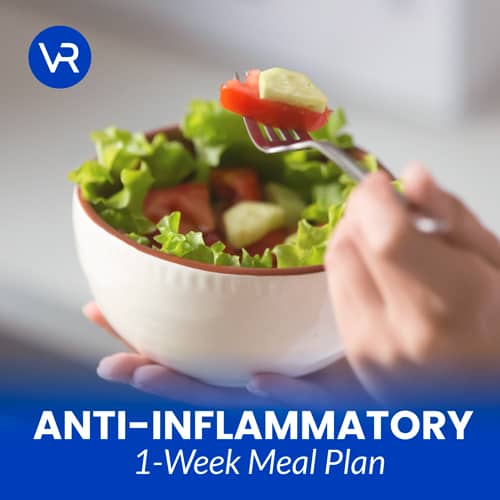
A meal plan to fight inflammation that’s both feasible AND affordable? It’s actually a lot easier than you may think. Follow this easy 1-week diet meal plan and say good-bye to bouts of inflammation immediately!
If you already have a high-inflammatory condition and want a meal plan to heal inflammation, this article is for you.
If you’re being proactive and want to prevent developing a high-inflammatory disease, this article is for you.
And hey...What if I were to tell you it’s possible to have an anti-inflammatory diet meal plan that is both affordable AND feasible?
One that can be easily incorporated into your already hectic schedule?
While most of us strive to eat better and exercise more, our busy schedules tend to make these things difficult. Especially if you already have a pre-existing medical condition, adding ANYTHING else to your crazy busy schedule can seem like an insurmountable task.
But! Worry not.
It is possible and more than do-able.
Buckle up and get ready to learn all about the anti-inflammatory lifestyle and some simple anti-inflammatory recipes!
What You Need to Know About Inflammation
Most of us have experienced inflammation at some point in time, and believe it or not, it is actually a good thing!
Like anxiety, many automatically assume inflammation is completely bad and should be avoided at all costs. But just like anxiety, inflammation is necessary biologically.
Mechanically, inflammation is a rush of blood to an injury to aid in the healing process; it can even help remove unwanted pathogens!
Pretty neat, eh?
This type of inflammation is the good kind. Intermediate spells of inflammation targeted towards specific compounds is extremely healthy for the body.
Inflammation becomes the enemy when it attacks invaders that don’t exist.
For reasons we don’t fully understand yet, sometimes the body misinterprets signals and thinks there is a foreign body or pathogen that needs to be eliminated, even though there’s nothing there.
And this can occur for daysssssssssss (months, years).
Chronic inflammation is the true enemy here.
Unfortunately, chronic inflammation has been linked to many diseases, like cancer, Alzheimer's disease, diabetes, arthritis, and depression.
Oof, that hits hard.
If that’s not a motivator to be better with my eating habits, I don’t know what is!
With this information in mind, let’s get to work on changing our bad habits! And at the end of this article, I have included an easy anti-inflammatory diet menu for 1 full week.
Let's dive in!
Anti-Inflammatory Foods and Drinks

Here’s a list of the seven most common foods and drinks known to reduce and prevent inflammation!
Good Fats
Many of us have been entrenched by the idea that all fat is bad. But evidence from recent studies suggests that mono unsaturated fats like extra virgin olive oil and avocado have anti-inflammatory properties and can potentially reduce the chance of coronary heart disease. Extra virgin olive oil, fatty fish, and avocados/avocado oil are considered to be “good” fats.
Leafy Green Vegetables
Common leafy green vegetables include spinach, kale, arugula, collard greens, and romaine lettuce. Kale specifically may help reduce the chance of heart disease and spinach with gastric mucosal injuries.
But I’m pretty sure every “healthy” article in the world lists leafy green vegetables in it somewhere! So why do we have such a hard time consuming them?
(I say we, I really mean me)
I think most of us associate leafy greens with words like boring, tasteless, unsatisfying, and bland. Or we go overboard and try to make every.single.meal a salad. Or we just don’t know even know what to do with them.
If you can relate, keep reading because I’m going to include some very easy AND tasty recipes with those dang leafy greens and their anti-inflammatory properties.
And I promise they aren’t all salads. Pinky-swear.
Omega-3 / Fatty Fish
Just like with leafy greens, one can't NOT mention omega-3’s at least once when talking about an anti-inflammatory diet.
There’s a solid reason for that!
Omega-3’s are thought to greatly reduce the chance of cardiovascular conditions, IBD, rheumatoid arthritis, and different types of cancer. Even the American Heart Association frequently totes the health benefits of eating fish.
Good sources of omega-3 include fatty fish like salmon, tuna, mackerel, and herring; walnuts; oysters; flaxseed; and chia seeds. Omega-3 supplements are worth looking into, too, but do try getting nutrients from the actual sources!
Have no idea how to incorporate flaxseed and chia seeds into your diet?
Check out the anti-inflammatory meal plan section below to find out!
Fruit
Yes, my fave! I love fruit and shopping at local markets to find the best deals! I love to eat fruit, but I’m also a cheapskate; so I always know what’s in season and what’s a good deal.
Sorry guys, back on topic...
But yes, fruits that have great anti-inflammatory components include strawberries, blueberries, cherries, and even apples!
Apparently there’s evidence-based truth to the saying.
Many fruits contain antioxidant compounds like flavonoids, polyphenols, anthocyanins, and other similar molecular groups. Antioxidants are well-known for their medicinal benefits and their ability to reduce oxidative stress, which is an essential part of the anti-inflammatory lifestyle.
Green Tea
Like some fruits, green tea also contains polyphenols, most importantly polyphenols like epigallocatechin gallate (EGCG). Believed to promote anti-inflammatory and anti-oxidative responses, EGCG can play an essential role in preventing cardiovascular diseases.
And for my matcha lovers like myself, you’ll be happy to know that matcha green tea has plenty of EGCG like regular green tea! I’ll include one of my fave matcha recipes below!
Red Wine
Not that we need any excuse to drink red wine, but did you know that small doses of red wine can have anti-inflammatory effects? It is thought to work by reducing elevated levels of plasma fibrinogen, which can be responsible for thick blood clots and high levels of inflammation.
Definitely adding that to my anti-inflammatory drink repertoire.
Certain Spices
Last, but certainly not least, spices. One of my favorite things about fall is the overabundant prevalence of cinnamon in foods and drinks! Spiced chai tea latte with extra cinnamon, I’m looking at you! But did you know that cinnamon is thought to help with inflammation, especially inflammation due to age-related diseases?
Turmeric, while less common than cinnamon, also is frequently toted for its anti-inflammatory properties. Additionally, it’s believed that turmeric contains anti-aging, anti-diabetic, and wound-healing components.
They really are the spice of life. #PunIntended #KeepingItSpicy
Word of Caution: Foods in The Nightshade Family

Most people find that incorporating foods like eggplant, tomatoes, potatoes, and peppers into their diet can decrease their inflammation levels.
But some experience the reverse!
Those people can experience increased inflammatory flare-ups after incorporating foods from the nightshade family. So slowly add these foods to your diet and see how you feel after a couple of weeks to determine if these foods are right for you.
(I'll have a FULL article about nightshades for you shortly, so stay tuned!)
A Full 1-Week Anti-Inflammatory
Meal Plan

Now, for those easy and delicious anti-inflammatory meals I promised you!
The following is a list of anti-inflammatory recipes (essentially a diet menu) for breakfast, lunch, snack time, and dinner!
Day 1 - Monday
Breakfast- Coconut (or any other dairy-free) yogurt topped with fruit and berries (my personal favorite is banana with blueberries and cinnamon). A cup of green tea
Lunch - Whole wheat wrap with chicken breast (roasted beforehand) slathered with hummus, avocado, spinach, bell peppers, tomatoes (list goes on - use whatever veggies you have sitting in the fridge!)
(Also: spice it up with some lemon pepper seasoning, it’s to die for!)
Snack - Mix of your favorite nuts, seeds and fresh or dried fruit (without added sugar)
Dinner - Grilled or oven-bake shrimp skewers with your favorite vegetables; end with some dry red wine if your heart so desires
(Hint: place shrimp and vegetables in a bag with olive oil, herbs, a squirt of lemon, and garlic a few hours before cooking to enhance the flavor)
Day 2 - Tuesday
Breakfast - Use fresh or left-over marinated vegetables from the night before to make a zesty omelet (need an idea? Try bell peppers, onions, okra, and mushrooms)
Lunch - Whole grain sandwich with leftover chicken breast and vegetables
(Personal favorite: cubed chicken, grapes, and celery tossed with honey mustard with romaine lettuce or spinach)
Snack - Whole grain avocado toast
Dinner -Spaghetti squash pasta drizzled with olive oil with a generous portion of pesto sauce and a handful of pine nuts, raw walnuts, or raw cashews
Pro tip: spaghetti squash pasta can also be cooked in a crockpot if you’re low on time.
Day 3 - Wednesday
Breakfast - smoothie of your choice (my favorite is strawberry banana with A LOT of spinach and/or kale, ginger, and a teaspoon of turmeric! Other awesome ideas: blueberries, leafy greens and cayenne; beet and berries)
Pro tip: make the smoothie the night before and let thaw for an hour the next day (I bring it with me to the gym so it can thaw by the time I’m done working out and have it on my way to work!)
Lunch - Chickpea salad with leafy greens, white or purple onions, black olives, chicken, olive oil, bell peppers, and pepper to taste
Tip: set aside some chickpeas for tomorrow’s snack and bell peppers for today’s snack!
Snack - Bell pepper sticks with guacamole or hummus
Dinner - Honey garlic salmon with a side of steamed broccoli (check out this recipe if you need details!)
Day 4 - Thursday
Breakfast - Whole wheat bagel with peanut or almond butter and honey
Lunch - Leftover salmon and spinach salad with celery, parsley, red onions, and your favorite dressing (preferably olive oil based)
Snack - Roasted chickpeas
Dinner -One-skillet Mediterranean chicken (skip the Feta cheese! If you want to fight inflammation through diet, dairy is not your friend)
Day 5 - Friday
Breakfast - Steamy oatmeal with a drizzle of honey, plant-based milk or water, chia seeds, and your fave fruit (either on top or on the side)
Lunch - Golden tofu scramble with turmeric, spinach, tomatoes, and whatever other suitable veggies and herbs you have at hand
Snack - Matcha green tea milkshake (check out the recipe here) or, if you're short on time, a handful of raw nuts and a cup of fresh ginger tea
Dinner - Use leftover spaghetti squash and pesto from Tuesday’s dinner to make this awesome pesto spaghetti squash with shrimp recipe. Bonus: cook and prep time is only 20 minutes!
Day 6 - Saturday
Breakfast - Whole grain toast with your favorite nut butter, bananas, and chia seeds
Lunch - Wild rice with cooked spinach and sunny-side-up egg with a side of your favorite fruit
Snack - Your choice of protein bar
Pro tip: on a free day, make a batch of homemade oatmeal protein bars with flaxseed or chia seeds, almonds, peanut butter, and honey and stick them in the freezer for later.
Dinner - Vegetable curry with sweet potatoes, cauliflower, broccoli, and carrots. Top it with a plant-based protein of choice (golden roasted chickpeas, tofu cubes, or crispy tempeh)
Pro tip: I always add A LOT more ginger and turmeric than a typical curry recipe would suggest, which helps enhance both flavor and anti-inflammatory properties of my meal!
Day 7 - Sunday
Breakfast - Whole wheat pancakes topped with your favorite fruit
(Tried-and-tested recipe: mix together 1/2 cup non-dairy yogurt, 1 large egg, 1 cup whole-wheat or buckwheat pancake mix, ¼ cup flaxseed, and 3/4 cup non-dairy milk. This is one of my favorite anti inflammatory recipes for breakfast, but it takes a bit long to whip up, if you're feeling lazy, there are plenty of much simpler recipes)
Lunch - Mediterranean pizza with whole wheat crust (need a recipe? Check out this one!)
Snack - Coconut milk chia pudding topped with fresh berries and fruit
Dinner - Grilled chicken with a side of your favorite vegetables.

Remember:
This is a general guideline, not something written in stone. That is the beauty of the anti-inflammatory diet; you can always adjust the plan to your dietary needs and preferences.
If you like these foods and want to make a conscious effort to incorporate them into your daily life, keep in mind that it’s easier to think of this as a lifestyle choice, not a diet.
Diet implies something temporary for a quick fix change and usually something you have to do for medical reasons.
A lifestyle choice is saying no to immediate, temporary pleasures so you can say yes to a lifetime of health and wellness. It’s also something you choose and get to do. The mind is the first battleground to tackle, then the kitchen.
Also, please remember:
As a service to our readers, Vital-Reaction Publishing provides access to our library of published content. No content on this site should EVER be used as a substitute for direct medical advice from your doctor or other qualified medical professionals.
References:
- https://www.health.harvard.edu/staying-healthy/foods-that-fight-inflammation
- https://www.health.harvard.edu/newsletter_article/Inflammation_A_unifying_theory_of_disease
- https://www.sciencedirect.com/science/article/abs/pii/S0021915006000402
- https://www.healthline.com/nutrition/top-10-evidence-based-health-benefits-of-coconut-oil
- https://www.medicalnewstoday.com/articles/270435.php
- https://www.jstage.jst.go.jp/article/jmi/57/3,4/57_3,4_314/_article/-char/ja/
- https://academic.oup.com/nutritionreviews/article-abstract/68/5/280/1829259
- https://www.heart.org/en/healthy-living/healthy-eating/eat-smart/fats/fish-and-omega-3-fatty-acids#.WyrYhlMvzOQ
- https://link.springer.com/article/10.1007/s00403-009-1001-3
- https://www.medicalnewstoday.com/articles/287710.php
- https://www.ncbi.nlm.nih.gov/pmc/articles/PMC3964743/
- https://www.ingentaconnect.com/content/ben/chddt/2007/00000007/00000002/art00008
- https://www.sciencedirect.com/science/article/pii/S0021967303011336
- https://www.sciencedirect.com/science/article/abs/pii/S0021915004001467
- https://pubs.rsc.org/en/content/articlelanding/2015/fo/c4fo00680a/unauth#!divAbstract
- https://onlinelibrary.wiley.com/doi/abs/10.1002/mnfr.201200838
- https://www.healthline.com/nutrition/5-studies-on-the-mediterranean-diet#section2




Leave a comment (all fields required)